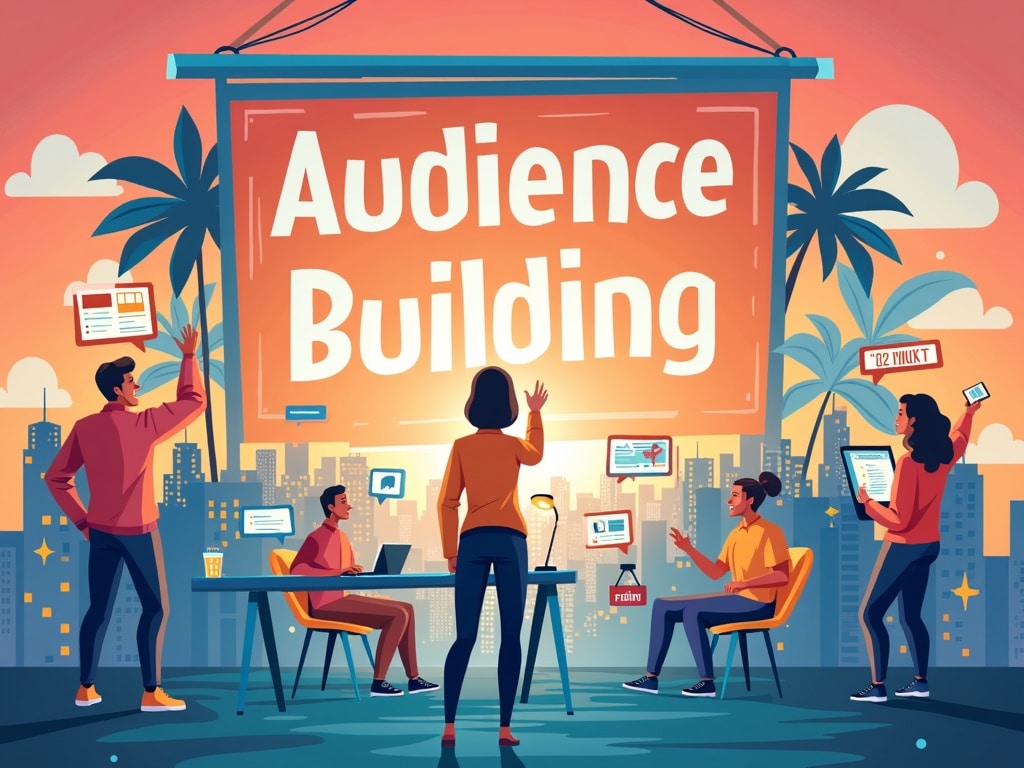Audience Building Tools for Entrepreneurs: A Comprehensive Guide
Imagine launching a revolutionary product or service, pouring your heart and soul into it, only to be met with…crickets. The harsh reality is that even the best ideas need an audience to thrive. As an entrepreneur, building a loyal and engaged audience is as crucial as securing funding or crafting a killer business plan. It’s the bedrock of sustainable growth, the source of invaluable feedback, and the key to long-term success. This guide dives deep into the essential audience building tools available to entrepreneurs, helping you cut through the noise and connect with the people who matter most.
Why Audience Building is Crucial for Entrepreneurs
Before we jump into the tools, let’s solidify why audience building deserves your focused attention. It’s more than just amassing followers; it’s about cultivating relationships.
**Validation and Feedback:Your audience provides real-time feedback on your products, services, and marketing efforts. This iterative process helps you refine your offerings and ensure they meet customer needs.
**Brand Advocacy: A loyal audience becomes your brand’s biggest advocates, spreading the word through word-of-mouth marketing and social sharing. This organic promotion is far more effective (and cost-effective) than traditional advertising.
**Increased Sales and Revenue: A nurtured audience translates directly into sales. They are more likely to purchase your products, subscribe to your services, and become repeat customers.
**Long-Term Sustainability: Building a community around your brand creates a buffer against market fluctuations and competitor activity. A strong audience provides stability and fosters long-term growth.
**Direct Communication Channel:An owned audience gives you a direct line of communication, bypassing the algorithms and gatekeepers of social media.
Defining Your Target Audience
You can’t build an audience without first understanding *whoyou’re trying to reach. This involves detailed research and the creation of ideal customer profiles, also known as buyer personas.
**Key questions to answer:**
**Demographics:Age, gender, location, income, education, occupation.
**Psychographics:Interests, values, lifestyle, attitudes, beliefs.
**Pain Points:What problems are they trying to solve? What challenges do they face?
**Goals and Aspirations:What are they hoping to achieve? What motivates them?
**Online Behavior:Where do they spend their time online? Which social media platforms do they use? What type of content do they consume?
Tools like surveys, customer interviews, and social media analytics can provide valuable insights when defining your target audience. Don’t be afraid to refine your personas as you gather more data and learn more about your audience.
Essential Audience Building Tools: A Deep Dive
Now, let’s explore the specific tools that can help you attract, engage, and retain a dedicated audience. These tools fall into several categories: content creation, social media management, email marketing, SEO, and community building.
Content Creation Tools
Content is the fuel that powers your audience building efforts. High-quality, valuable content attracts new followers, keeps them engaged, and establishes you as an authority in your niche.
**Blog Platforms (WordPress, Medium, Ghost):A blog is the cornerstone of your content strategy. Share insightful articles, tutorials, case studies, and opinion pieces relevant to your target audience. WordPress is a popular, highly customizable option, while Medium offers a built-in audience and streamlined publishing experience. Ghost provides a faster, more modern alternative focused on publishing.
**Graphic Design Tools (Canva, Adobe Creative Cloud Express, Figma): Visually appealing content is essential for capturing attention online. Canva offers a user-friendly drag-and-drop interface for creating stunning social media graphics, presentations, and marketing materials. Adobe Creative Cloud Express provides more advanced features, while Figma excels in collaborative design projects.
**Video Editing Software (Adobe Premiere Rush, iMovie, Descript): Video content is incredibly engaging and effective for building an audience. Adobe Premiere Rush is a versatile option for creating professional-looking videos on your phone or computer. iMovie is a free and easy-to-use option for Mac users. Descript is a unique tool that combines video and audio editing with transcription, making it easy to edit your content by editing text.
**Podcast Hosting Platforms (Buzzsprout, Libsyn, Anchor): Podcasting is a powerful way to connect with your audience on a more personal level. Buzzsprout and Libsyn are popular platforms that offer hosting, distribution, and analytics tools. Anchor is a free platform that makes it easy to create and distribute podcasts.
**AI Writing Assistants (Jasper.ai, Copy.ai, Rytr):These tools can assist with generating content ideas, writing blog posts, and crafting social media copy. They can save time and effort, but remember to always edit and proofread the output to ensure accuracy and maintain your brand voice.

Social Media Management Tools
Streamline your social media efforts and maximize your reach with these tools.
**Social Media Scheduling Tools (Buffer, Hootsuite, Sprout Social): These tools allow you to schedule posts in advance, saving you time and ensuring consistent activity on your social media channels. Buffer and Hootsuite are popular options with user-friendly interfaces and robust features. Sprout Social offers more advanced analytics and reporting capabilities.
**Social Listening Tools (Mention, Brandwatch, Awario): Monitor social media for mentions of your brand, competitors, and industry keywords. This allows you to identify trends, respond to customer inquiries, and gain valuable insights into your audience’s sentiments.
**Analytics Tools ( native platform analytics):Each social media platform offers its own analytics dashboard, providing insights into your audience demographics, engagement rates, and the performance of your posts. Regularly review these analytics to identify what’s working and what’s not.
Email Marketing Tools
Email marketing remains one of the most effective ways to nurture your audience and drive sales.
**Email Marketing Platforms (Mailchimp, ConvertKit, ActiveCampaign): These platforms provide the tools you need to build an email list, create engaging email campaigns, and track your results. Mailchimp is a popular option for small businesses, while ConvertKit is tailored towards creators and entrepreneurs. ActiveCampaign offers more advanced automation and segmentation features.
**Lead Magnet Creation Tools (leadpages, Unbounce, OptinMonster): Attract subscribers to your email list by offering valuable incentives, such as ebooks, checklists, templates, or free consultations. These tools help you create landing pages and opt-in forms to capture leads effectively.
SEO Tools
Search Engine Optimization (SEO) helps you attract organic traffic to your website and content, expanding your audience reach.
**Keyword Research Tools (Semrush, Ahrefs, Google Keyword Planner): Identify the keywords that your target audience is searching for online. These tools provide data on search volume, competition, and related keywords, helping you optimize your content for search engines.
**SEO Audit Tools (Screaming Frog, SEMrush Site Audit): Identify technical issues on your website that may be hindering your SEO performance. These tools crawl your website and provide reports on broken links, missing metadata, and other issues that need to be addressed.
**Rank Tracking Tools (SEMrush, Ahrefs): Monitor your website’s ranking in search results for your target keywords. This allows you to track your SEO progress and identify opportunities for improvement.
Community Building Tools
Fostering a sense of community around your brand can create loyal advocates and drive engagement.
**Forum Software (Discourse, phpBB): Create a dedicated forum where your audience can connect, ask questions, and share ideas. Discourse offers a modern and user-friendly interface, while phpBB is a more traditional option.
**Community Platforms (Facebook Groups, Slack, Discord): Leverage existing community platforms to build a following around your brand. Facebook Groups are a popular option for general audiences, while Slack and Discord are often used for more niche communities.
**Live Streaming Platforms (Twitch, YouTube Live, Facebook Live): Connect with your audience in real-time through live video streams. This allows you to answer questions, provide behind-the-scenes glimpses, and build personal connections.
Measuring Your Audience Building Success
Don’t just blindly implement these tools – track your progress and measure your results. Key metrics to monitor include:
**Website Traffic: Track the number of visitors to your website, as well as the sources of that traffic.
**Social Media Engagement:Monitor likes, comments, shares, and follower growth on your social media channels.
**Email List Growth:Track the number of subscribers to your email list, as well as open rates and click-through rates.
**Conversion Rates:Measure the percentage of website visitors who convert into leads or customers.
**Customer Satisfaction: Gather feedback from your audience through surveys, reviews, and social media monitoring to gauge their satisfaction with your brand.
By analyzing these metrics, you can identify what’s working and what’s not, allowing you to optimize your audience building efforts for maximum impact.
Tips for Choosing the Right Tools
With so many audience building tools available, it can be overwhelming to choose the right ones for your business. Consider these factors:
**Your Budget: Many of these tools offer free trials or freemium plans. Start with the free options and upgrade as your needs grow.
**Your Technical Expertise: Choose tools that are easy to use and integrate with your existing systems.
**Your Specific Needs: Identify the specific goals you want to achieve with audience building, and choose tools that align with those goals.
Scalability:As the business grows, you need to know that the tools at your disposal will scale up with you.
**Reviews & reputation:Don´t forget to check online reviews to get a gauge of other entrepreneurs experience with each tool.
Final Thoughts: Building Relationships, Not Just Audiences
Building a thriving audience is an ongoing process that requires consistent effort and a genuine commitment to providing value. Focus on building relationships, not just amassing followers. Engage with your audience, listen to their feedback, and create content that resonates with their needs and interests. By using the right tools and strategies, you can cultivate a loyal and engaged audience that will support your entrepreneurial journey for years to come. Remember the value you provide should be front and center in the audience building strategy.

